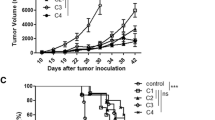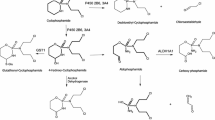Abstract
FCE 23762 (3′ desamino-3′[2(s)methoxyl-4-morpholinyl]doxorubicin) is a new doxorubicin (Dx) derivative that has been selected for clinical testing for its favourable antitumor characteristics, which include efficacy on Dx-resistant tumors. Immunosuppression is an undesirable side-effect of anti-cancer chemotherapy and the therapeutic efficacy of Dx is probably also related to its low immunotoxicity. It was, thus, of interest to compare the effects of FCE 23762 and its parental drug on the immune responses Both compounds were injected i.v. into healthy mice at equitoxic doses and according to different treatment schedules. Single doses of FCE 23762 and Dx, given concomitant or after the antigen, suppressed at the same degree and dose-dependently the primary anti-SRBC antibody response. Following a multiple treatment schedule after the antigen, FCE 23762 was less suppressive than Dx on both primary and secondary antibody production. Differently from Dx, that was completely inactive, FCE 23762 moderately inhibited DTH reaction to SRBC, only at the highest single dose tested or for repeated administrations given simultaneously or after priming. Both drugs were totally ineffective in delaying skin allograft rejection. Since spleen cellularity andex vivo lymphocyte proliferation to Con A and LPS were similarly impaired by the two drugs, the differentiated immunodepressive activity of FCE 23762 and Dx cannot be merely associated to their cytotoxic and antiproliferative action. The hypothesis of a selective effect on different regulatory cell subsets and/or immune mechanisms is discussed.
Similar content being viewed by others
References
M. Rothenberg and V. Ling,Multidrug resistance: Molecular biology and clinical relevance. J. Natl. Cancer Inst.81, 907–913 (1989).
L. J, Goldstein, H. Galski, A. Fojo, M. Willingham, S. L. Lai, A. Gazdar, R. Pirker, A. Green, W. Crist, G. M. Brodeur, M. Lieber, J. Cossman, M. M. Gottesman and I. Pastan,Expression of multidrug resistance gene in human cancers. J. Natl. Cancer Inst.81, 116–124 (1989).
M. Grandi G. Pezzoni, D. Ballinari, L. Capolongo, A. Suarato, A. Bargiotti, D. Faiardi and F. Spreafico,Novel anthracyclines analogs. Cancer Treat. Rev.17, 133–138 (1990).
W. Watanabe, W. Komeshima, S. Nakajima and T. Tsuruo.MX 2 a morpholino anthracycline, as a new antitumor agent against drug-sensitive and multidrug-resistant human and murine tumor cells. Cancer Res.48, 6653–6657 (1988).
M. Ripamonti, G. Pezzoni, E. Pesenti, A. Pastori, M. Farao, A. Bargiotti, A. Suarato, F. Spreafico and M. Grandi,In vivo antitumor activity of FCE 23762, a methoxymorpholinyl derivative of doxorubicin active on doxorubicin-resistant tumor cells. Br. J. Cancer65, 703–707 (1992).
A. M. Casazza, A. M. Isetta, N. Giuliani and M. Di Marco,Immunosuppressive activity of daunomycin and adriamycin. InAdriamycin review, Part II. (Ed. M. Staquet) pp. 123–131. Euro Press Medikon, Ghent, Belgique 1975.
A. Vecchi, A. Mantovani, A. Tagliabue and F. Spreafico,A characterization of the immunosuppressive activity of adriamycin and daunomycin on humoral antibody production and tumor allograft rejection. Cancer Res.36, 1222–1227 (1976).
A. Mantovani, M. Luini, G. Peri, A. Vecchi and F. Spreafico,Effect of chemotherapeutic agents on natural cellmediated cytotoxicity in mice. J. Natl. Cancer Inst.61, 1255–1261 (1978).
E. Mihich and M. J. Ehrke,Immunomodulating effect of anti-cancer drugs: The example of adriamycin. Transplantation Proc.XVI, 499–501 (1984).
P. E. Billingham and P. B. Medawar,The technique of free skin in mammals. J. Exp. Biol.28, 385–390 (1951).
D. Trizio, C. Della Bruna and A. M. Isetta,Modification of immune responsiveness in murine Schistosomiasis Mansoni. I. Time course after cercarial exposure. Immunology40, 353–358 (1980).
A. Mantovani, A. Vecchi, A. Tagliabue and F. Spreafico,The effect of adriamycin and daunomycin on antitumoral effector mechanisms in an allogenic system. Eur. J. Cancer12, 371–380 (1976).
M. J. Ehrke, S. A. Cohen and E. Mihich,Selective effects of Adriamycin on murine host defence system. Immunol. Rev.65, 55–68 (1982).
M. J. Ehrke, K. Ryoyama and S. Cohen,Cellular basis for adriamycin induced augmentation of cell mediated cytotoxicity in culture. Cancer. Res.44, 2497–2504 (1984).
A. M. Isetta, M. C. Fornasiero, M. Ferrari and D. Trizio,Immunosuppressive activity of 4′-iodo-4′-deoxy-doxorubicin on humoral and cell-mediated immune responses in mice. Comparison with doxorubicin. Int. J. Immunopharmacol.12, 665–673 (1990).
A. Mantovani,In vitro and in vivo cytotoxicity of adriamycin and daunomycin for murine macrophages. Cancer Res.37, 815–820 (1977).
S. J. Haskill,Adriamycin activated macrophages as tumor growth inhibitors. Cancer Res.41, 3852–3856 (1981).
A. Santoni, C. Riccardi, V. Sorci and R. B. Herberman,Effects of adriamycin on the activity of mouse natural killer cells. J. Immunol.124, 2329–2335 (1980).
F. Spreafico,On the immunopharmacology of cancer chemotherapeutics. InModels and Methods in the Immunotherapy and Chemotherapy of Cancer. Eds. F. R. Sciler and H. G. Schwich) pp. 230–238, Berling Inst. Mitt. no 74, 1984.
M. J. Ehrke, D. Maccubin, K. Ryoyama, S. A. Kohen and E. Mihich,Correlation between adriamycin-induced augmentation of interleukin 2 production and cell-mediated cytotoxicity in mice. Cancer Res.46, 54–60 (1986).
M. J. Ehrke and E. Mihich,Effects of anticancer agents on immune responses. Trends Pharmacol. Sci.6, 412–517 (1985).
B. M. Hall,Cell mediating allograft rejection. Transplantation51, 1141–1151 (1991).
J. Klein,Delayed-type hypersensivitity. In:Immunology pp. 451–459. Blackwell Scientific Publications, Boston 1991.
F. Spreafico,The immunological activity of anthracyclines. InAnthracylines Antibodies in Cancer Therapy. (Eds. F., Muggie, C. N. Young and S. K. Carter) pp. 50–68, Nijhoff N. Publ. Co., The Hague 1982.
Author information
Authors and Affiliations
Rights and permissions
About this article
Cite this article
Fornasiero, M.C., Ferrari, M., Gnocchi, P. et al. Immunodepressive activity of FCE 23762 on humoral and cell-mediated immune responses in normal mice: comparison with doxorubicin. Agents and Actions 37, 311–318 (1992). https://doi.org/10.1007/BF02028125
Received:
Accepted:
Issue Date:
DOI: https://doi.org/10.1007/BF02028125




